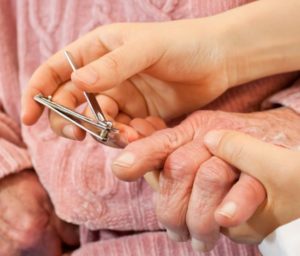 The body undergoes multiple changes with age, including muscle loss and the development of certain health conditions. Fingernails also start to thicken or become more brittle. For yourself or a loved one, be aware of the following factors when it comes to your nails.
The body undergoes multiple changes with age, including muscle loss and the development of certain health conditions. Fingernails also start to thicken or become more brittle. For yourself or a loved one, be aware of the following factors when it comes to your nails.
Fingernail Changes
Age can cause your nails to harden, thicken and lose their glossy translucence, which results in a yellow, often dull appearance. As keratin breaks down, nails may also thin and become more fragile, increasing your risks for breakage and fungal infections.
Additionally, fingernail quality can indicate the presence of certain diseases. As such, you’re advised to have your nails examined regularly by a podiatrist. For basic nail care:
- Get your finger and toenails trimmed and shaped regularly. If you’re unable to yourself, have a professional or loved one do it for you.
- If your nails start to thicken, apply moisturizer to help make them easier to cut.
- Pay attention to ridges. Vertical ridges occur with age, but horizontal ridges and pitting can indicate certain health conditions, including a zinc deficiency, certain cardiovascular diseases, a thyroid issue or psoriasis.
- Pay attention to discoloration. Yellow or gray tones emerge with age but dark patches can indicate a fungal infection, bruising or melanoma.
- Also be aware of the shape. Certain curves can indicate an iron deficiency or heart, respiratory or kidney issues.
Caring for Your Fingernails With Age
Nail clipping, cuticle trimming and applying nail polish often aren’t enough. Instead, older adults are advised to take the following steps to maintain their nail health.
See a Podiatrist
Seniors have a higher risk for ingrown toenails, a condition leading to discomfort and infection. Age can also pose issues with clipping toenails, including mobility and dexterity changes. Certain age-related health conditions like diabetes also increase your risk for a toenail infection.
Considering these factors, you’re recommended to routinely see a podiatrist to have your nails trimmed, shaped and your foot health thoroughly assessed.
Routinely Trim and Shape Your Nails
Between podiatrist appointments, have your nails trimmed about every two weeks. This helps control germs, dirt and accumulating skin cells to reduce infection risks. Your nails should also be shaped correctly to avoid snags, chips and ingrown toenails.
If your nails have started to thicken, get in the habit of applying moisturizer, trim right after you bathe or soak your feet in Epsom salts.
To lessen cutting risks, file the nail to limit sharp edges. Based on your dexterity level and support system, consider using an electric nail clipper over the traditional manual option.
Be Mindful of Footwear and Socks
Let your feet breathe, but not to the point a lack of footwear creates a trip or other safety hazard. Wearing socks all the time creates a moist environment, allowing foot fungus to grow. Considering this:
- Limit how often you wear nail polish.
- Make sure your shoes have treads on them to reduce fall risks.
- Don’t wear your shoes all the time.
- Spend part of the day barefoot to limit foot fungus growth.
- If you go outdoors, have full foot protection to reduce exposure to dirt.
Keep Your Nails Clean
Along with clipping, look for dirt around your nails, which can increase risk for infection. Intentionally wash your nails during a shower or bath and check your hands after washing dishes and cleaning.
Pay Attention to Your Diet
Make sure your diet supports your nail health, preferably with foods higher in zinc, vitamin C, collagen and biotin. Eat more fruits, lean proteins, fish, nuts, eggs, whole grains, leafy greens, calcium and consider adding select supplements to strengthen your nails.
Lifestyle Changes
Due to decreased nail strength:
- Avoid using your nails as a blade or other tool, as you risk tearing or breaking them. Instead, use a pair of scissors or box cutter.
- While you can paint your nails on occasion, avoid acrylics and gel manicures, as these wear down already-thin nails and expose them to adhesives.
Are you concerned about your own or a loved one’s nail health? The medical professionals at Avon Health Center regularly assess the finger and toenail quality of our residents to identify potential health conditions and reduce infection risks. To learn more, contact us today.
« Signs of Hearing Loss in Seniors

